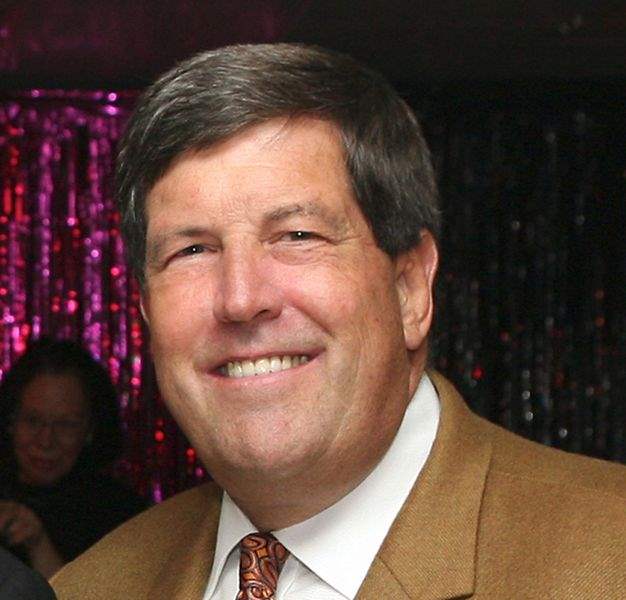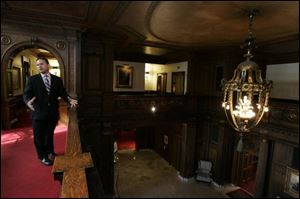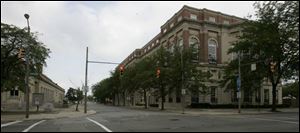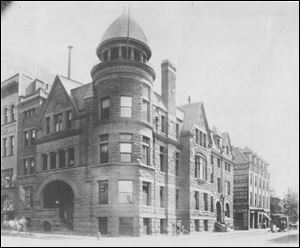
Exclusive Toledo Club copes with new realities
7/29/2007
Wilcox
Office of Marketing & Communicat
Beneath the heavy chandeliers and portraits of the city s industrial forefathers hanging in the Toledo Club, Fred Bostleman lunches each Wednesday with a group of fellow retirees.
The men talk about the one thing missing from the ornate dining room they cherish: new members.
Where are all the people? What do you have to do to bring them in here? wonders Mr. Bostleman, 86. It s not going to continue with the road it s on. You just hate like hell to see it shut down.
Presidential aspirants claim America has roared back to a gilded age. About 30 percent of the national income belongs to just 5 percent of the population, according to IRS data.
That level of inequality last surfaced during an era of phonographs, bob haircuts, and bath tub gin, when bootleggers could sneak liquor into the Toledo Club through an elevator shaft now hidden by a scarlet curtain.
Yet the nation s gilded renaissance has not revived the Toledo institutions from that storied era. With a city focused on the painful disappearance of blue-collar jobs, few noticed the degree to which white-collar jobs also vanished.

The ornate doorway on 14th is no longer the club s main entrance.
Between 1997 and 2006, metropolitan Toledo lost 570 CEOs and 7,710 managers, more than 40 percent of each group, according to surveys by the Bureau of Labor Statistics. Those losses are most visible at the centers of business and civic affairs.
The Toledo Club has about 850 members. It lowered fees earlier this year, hoping to stem a membership decline by bringing in a younger generation. Club members recently were charged a $1,000 assessment beyond their monthly dues to help bolster finances.
The club also launched a $500,000 capital campaign to improve athletic facilities and spruce up the building.
After choosing to open its once-restricted French doors to the public, the club now derives about 80 percent of its revenues from hosting banquets, said John Nowowiejski, the food and beverage director.
The 118-year-old club applied earlier this year to establish a foundation that would receive gifts from the estates of soon-to-be departed members and donations to maintain the historic downtown club at Madison Avenue and 14th Street.

John Nowowiejski, food and beverage director of the Toledo Club, says 80 percent of the club s revenue is now derived from hosting banquets for outside organizations and other groups.
We re not closing tomorrow, but clearly the trends are not in our favor, said Dirk VanHeyst, president of the club s board of directors. But there s a commitment by the board, the management, and the members to continue the Toledo Club.
A foundation to help preserve the Toledo landmark may be the vehicle that restores the club to its past grandeur. Such a foundation has been used before successfully.
Members of the Metropolitan Club in New York City make monthly tax-deductible donations to the 1 East 60th Foundation, which helps maintain the historic Manhattan club at 1 East 60th St., at Fifth Ave.
Problems elsewhere
The problem extends to the plush greens of clubs outside the downtown. The Toledo Country Club, the Inverness Club, the Sylvania Country Club, and the Belmont Country Club in Perrysburg Township each racked up six-figure operating deficits in recent years, according to tax filings for the nonprofit clubs.
In fiscal 2005, the most recent year available, the Toledo Country Club lost $151,397, and the Belmont Country Club lost $234,486. A year earlier, the Sylvania Country Club lost $117,320, and the Inverness Club lost $346,621.

The imposing Toledo Club building looms over the intersection of Madison Avenue and 14th Street in the western reaches of downtown Toledo.
And the consequences affect people who have never golfed at Inverness, nor tasted the creamy tomato soup from the Toledo Club.
The mean salary of the 730 remaining CEOs approaches $144,130, more than four times a typical resident s earnings. The Bureau of Labor Statistics counts CEOs as heads of companies, nonprofits, and government agencies.
The area s 11,050 managers who range from executives to legislators to school board administrators average $84,330.
Because Toledo levies a 2.25 percent tax on incomes, higher salaries translate into more money for police, fire, and basic city services. As of June, Toledo spent $162.4 million, $2.2 million more than it collected in taxes. No question is this a major effect, along with the loss of manufacturing jobs, says Toledo City Councilman George Sarantou, chairman of the finance and budget committee.
I think there is a direct correlation. Back in the 1970s, we had seven Fortune 500 companies in Toledo. We re nowhere close to that now.
Toledo remains the headquarters for two Fortune 500 companies, the bankrupt Dana Corp. and the fresh-from-bankruptcy Owens Corning. A third Fortune 500 company, Owens-Illinois, left for Perrysburg last year.

Wilcox
None of those corporations offers club memberships as part of their executive compensation packages, spokesmen said.
We stopped doing that a number of years ago, says Dana spokesman Chuck Hartlage. The reason is we looked at companies similar to us. They were dropping benefits, so we did as well.
Memberships dropped
Of the area s two largest employers, ProMedica Health System does not provide club memberships and Mercy Health Partners covers the initiation fee for its president and CEO but not his dues.
Mike Wilcox, the CEO of Wilcox Financial in Toledo, noted that companies can no longer deduct club memberships from their federal taxes. Many also have their own dining facilities or confidentiality agreements requiring them to hold business lunches in more private venues than the Toledo Club.
As a result, Mr. Wilcox no longer visits the club three times a day for breakfast, lunch, and a workout. But he encouraged his son to join after graduating from college last year because the Harvard brick and Indiana limestone building still gives budding entrepreneurs a place to network. Still, out of loyalty to the club s future, Mr. Wilcox says the Toledo Club needs an aggressive makeover in order to give value and stake to members.

The ornate building, at Madison Avenue and Huron Street was the original location of the club. Its guests included Presidents William McKinley, Theodore Roosevelt, and William H. Taft.
With the Toledo Club, you should either put a bullet in it or fix it, he says. To let it die a slow death is undignified.
The club says it strives to keep current with changes in society. Besides the in-house barber and tailor, weekday baby-sitting services come with the $500 initiation fee and $130 in monthly dues for members between 31 and 35.
Older members pay more. Younger members pay less.
And after a controversial incident in 1995 when exotic dancers performed a lingerie show at the annual men s dinner, women members found it easier to eat in the previously segregated grill room, informally still called the men s grill by some.
Even if the Toledo Club successfully transitions to being a center for family activities (complete with 99-cent children s meals each Tuesday night), it faces the obstacle of being in a midsized rust-belt city.
Fewer executives
The Bureau of Labor Statistics could not explain the drop in Toledo s executive class, which tracks with a national trend. America shed 297,540 CEOs between 1997 and 2006.
Part of the decline could be attributed to mergers and acquisitions, said Mike Carroll, director of the Center for Regional Development at Bowling Green State University. Based on his research, Mr. Carroll says mergers lead to the concentration of CEOs in more populous areas.
It s probably three times more likely that the predator firm will come from a larger city, he says. The social implication is that the managers of branch firms don t get involved in community issues.
Such is the case for the former France Stone Co., which quarries and crushes limestone products. The Sylvania-based firm began hosting a country-style brunch at the Toledo Club in 1937, bringing together political rivals so that the city could receive public works funds from New Deal programs.
The brunch ended in the 1990s after a series of acquisitions put a British firm, Hanson PLC, in control of France Stone, which became Hanson Aggregates Midwest.
When the brunches started, the club was grappling with the Great Depression. In 1932, 336 members left its rolls, putting membership at 664, according to board meeting minutes.
The club managed to survive and flourish. Behind it were the legacies of Edward Drummond Libbey, whose glass fortune paid for the Toledo Museum of Art; Michael Owens, the glass blower who could machine a bottle, and John North Willys, whose Willys-Overland Co. developed the Jeep.
Paintings of them overlook the main dining room. As Mr. Nowowiejski, the food and beverage director, led a tour through the elegant and near-empty space last Thursday morning, he struggled to answer whether these men had any heirs in modern-day Toledo.
That s a tough question, he said.
Contact Joshua Boak at:jboak@theblade.comor 419-724-6728.